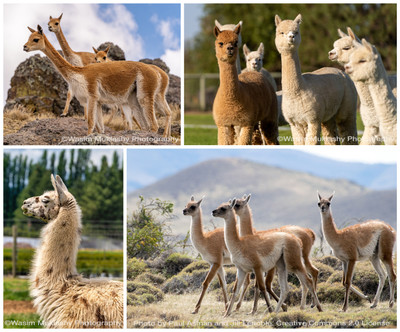Exploring the Unique Differences Between Alpacas, Guanacos, Llamas, and Vicuñas
Alpaca by Design on Aug 16th 2023
In the heart of South America's breathtaking landscapes, four captivating camelid species—alpacas, guanacos, llamas, and vicuñas—capture the imagination with their distinct characteristics. While these animals might appear similar at first glance, they each possess unique traits that set them apart. In this post, we will delve into the remarkable differences between alpacas, guanacos, llamas, and vicuñas, shedding light on their habitats, physical attributes, behaviors, and cultural significance.
Habitat and Geographic Range
These four camelid species have distinct preferences when it comes to their habitats and geographic ranges:
1. Alpacas: Alpacas thrive in the high altitudes of the Andes Mountains, mainly in Peru, Bolivia, Ecuador, and northern Chile. Their exceptional adaptability to cold climates makes them well-suited for life in these challenging environments.
2. Guanacos: Guanacos inhabit diverse landscapes including grasslands, scrublands, and mountains across South America. They are found from southern Peru to the southern tip of Patagonia, showcasing their adaptability to varying ecosystems.
3. Llamas: Llamas are domesticated animals known for their roles as pack animals and beasts of burden. They are often found in the Andes regions of Peru, Bolivia, Ecuador, and parts of Argentina and Chile, where their assistance is invaluable for local communities.
4. Vicuñas: Vicuñas are the smallest and most delicate of the four species. They inhabit the high, barren plateaus of the Andes, primarily in Peru, Bolivia, Chile, and Argentina. These graceful creatures are well-adapted to surviving in the harsh conditions of their habitat.
Physical Attributes
While alpacas, guanacos, llamas, and vicuñas share a common ancestry, they each possess distinct physical attributes:
1. Alpacas: Alpacas are smaller in size, standing at around 32 to 39 inches tall at the shoulder. They have a stocky build and are recognized for their soft and luxurious fleece, available in a range of natural colors.
2. Guanacos: Guanacos are larger and more slender, measuring about 43 to 51 inches in height at the shoulder. Their coat is coarser and typically tawny or reddish-brown, aiding in camouflage within their surroundings.
3. Llamas: Llamas are similar in size to alpacas but have a more robust build. They are distinctively recognized by their long necks and banana-shaped ears. Llamas are bred for their strength and endurance, making them suitable for carrying heavy loads.
4. Vicuñas: Vicuñas are the smallest of the four species, standing at about 26 to 34 inches at the shoulder. They possess a delicate frame and sport a fine, dense fleece that is highly valued for its quality.
Behavioral Traits
The behavioral contrasts among these species reflect their diverse adaptations:
1. Alpacas: Alpacas are social animals that thrive in herds, providing protection and companionship. They are primarily raised for their wool, which is used in textile production.
2. Guanacos: Guanacos exhibit a more territorial and independent behavior. They tend to roam in smaller groups or individually, allowing them to cover vast distances in search of food.
3. Llamas: Llamas are known for their gentle and obedient nature. They have played a vital role in the livelihoods of Andean communities, assisting with transportation and providing wool and meat.
4. Vicuñas: Vicuñas are known for their elusive behavior and agility. They are cautious creatures, which helps them evade predators in their challenging mountain habitats.
Cultural Significance
These camelids have left an indelible mark on the cultures and histories of South America:
1. Alpacas: Alpacas have been revered for their prized fleece, historically reserved for royalty. They hold cultural and spiritual significance, symbolizing prosperity and divinity.
2. Guanacos: Guanacos have provided indigenous communities with sustenance through their meat and hides, contributing to ancestral survival.
3. Llamas: Llamas have served as essential companions for the Andean people, aiding in their agricultural and transportation needs.
4. Vicuñas: Vicuñas are protected species due to their delicate population. Their impossibly fine fleece is harvested sustainably, contributing to local economies. To read more about the captivating process of harvesting the fibers from these wild animals, check out this account by one of our owners of experiencing a traditional Vicuña chaccu, the ancient Sun God ritual used to this day of corralling and shearing these magical creatures.
As we explore the differences between alpacas, guanacos, llamas, and vicuñas, we gain a deeper understanding of the remarkable adaptations that have enabled these species to thrive in their distinct environments. Their physical attributes, behaviors, and cultural significance enrich the biodiversity and history of South America, reminding us of the intricate relationships between nature and human culture.

